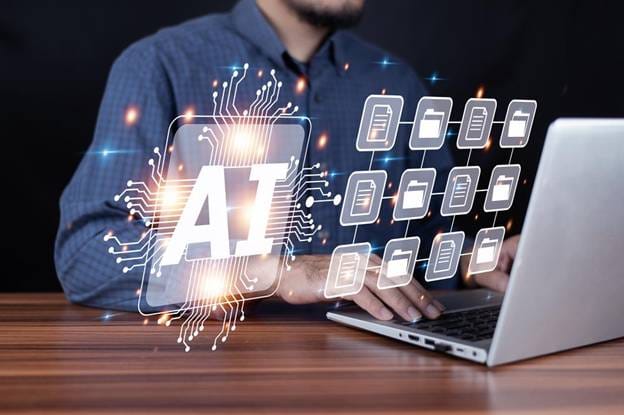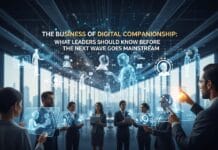
AI-powered tools and state-of-the-art devices are revolutionizing today’s workplaces and redefining productivity. Modern workplace technology combines digital transformation tools with mobile work solutions, driving unprecedented efficiency. From automation to data-driven insights, AI transforms how businesses operate, collaborate, and deliver customer value. This transformation empowers teams to remain agile and productive across various work environments.
In this article, we will explore how AI-powered tools are driving digital transformation, their top uses in the workplace, and how they support mobile and remote work solutions. Read on to learn how to leverage AI to stay ahead of your competition!

What is AI?
Artificial Intelligence (AI) refers to the simulation of human intelligence processes by machines, particularly computers. These processes include learning (acquiring information), reasoning (solving problems), and self-correction. AI is now integrated into various business operations such as Depositphotos API, from chatbots assisting customer service to advanced data analytics tools guiding strategic decision-making. With the rise of AI, digital transformation tools have become indispensable in improving business efficiency, enhancing customer satisfaction, and fostering innovation.
How are AI-powered tools driving digital transformation?
AI-powered tools are revolutionizing business operations through four transformative channels that fundamentally reshape organizational capabilities. These strategic innovations create unprecedented opportunities for growth and efficiency across industries, driving measurable business value.
- Automation of repetitive tasks. AI algorithms now handle routine operations like data entry, document processing, and scheduling, freeing employees to focus on strategic initiatives and creative problem-solving. Such automation reduces errors, saves costs, and increases efficiency and productivity by 40%, as seen with the use of the Microsoft Copilot tool.
- Data-driven insights. Advanced analytics engines process vast datasets to uncover actionable business intelligence. This allows companies to identify trends, forecast demand, and optimize marketing strategies, gaining a competitive advantage while making informed decisions that drive growth and profitability.
- Enhanced customer experience. AI-driven personalization engines analyze customer behavior patterns to deliver tailored interactions. This results in higher satisfaction rates and increased loyalty across digital touchpoints.
- Improved collaboration. AI-powered collaboration tools enhance organizational communication and teamwork through smart scheduling, automated task management, and predictive resource allocation. This allows teams to work seamlessly across time zones and geographic locations.
Top uses of AI-powered technology in a modern workplace
Customer support
AI-powered customer support solutions are transforming business-client interactions through real-time analysis and personalized responses.
- Smart chatbots handle 70% of routine inquiries instantly, ensuring 24/7 support;
- Intelligent routing systems match complex cases with specialized agents;
- Sentiment analysis engines detect customer emotions and prioritize urgent cases;
- Automated responses improve through interaction learning.
This integration delivers faster response and resolution times while providing accurate information, maintaining high satisfaction across support channels, and reducing operational costs.
Predictive analytics
Predictive analytics powered by AI is helping businesses with forecasting and strategic planning. AI tools analyze historical data and use algorithms to predict future outcomes, such as sales trends, customer behavior, and inventory needs. This foresight allows businesses to plan proactively, mitigate risks, and optimize resource allocation.
- Financial forecasting engines predict market trends, optimizing resource allocation;
- Supply chain algorithms reduce inventory costs through demand prediction;
- Sales pipeline analysis tools identify high-potential leads;
- Equipment maintenance forecasting prevents breakdowns through early detection.
Talent management
AI-powered tools are used in human resources (HR) for recruitment, talent management, and employee engagement.
- Smart screening engines analyze candidate profiles with greater accuracy than manual methods;
- Performance analytics tools predict employee success patterns through behavioral analysis;
- AI-powered skill mapping identifies development opportunities across teams;
- Intelligent retention systems forecast flight risks;
- Automated onboarding workflows reduce training time.
By integrating these AI capabilities, organizations achieve faster hiring cycles while reducing turnover costs and improving team satisfaction through personalized development paths.

Process automation
Process automation through AI helps businesses streamline operations, from automating invoice processing to supply chain management, by eliminating bottlenecks and reducing human error.
- Intelligent document processing reduces manual handling time by 85%, automatically extracting and validating critical information;
- Workflow orchestration engines coordinate cross-departmental tasks;
- Smart quality control systems detect and prevent process deviations;
- Automated compliance monitoring ensures regulatory adherence across operations;
- Real-time analytics dashboard tracks performance metrics and optimization opportunities.
By freeing employees from mundane tasks, businesses can allocate resources to more strategic initiatives that contribute to growth and innovation.
How AI solutions help with mobile and remote work
With the increasing demand for mobile work solutions and remote work essentials, AI-powered tools are essential for ensuring that employees can work efficiently from anywhere. Here’s how AI supports mobile and remote work:
Seamless integration across devices
AI-powered synchronization enables seamless workflow transitions across devices, ensuring that employees can access information and collaborate effortlessly, whether they are working on a laptop or a mobile device. By syncing work across multiple platforms, AI makes it easier for teams to stay connected and productive, no matter where they are located.
Remote monitoring and support
AI-powered monitoring platforms transform remote workforce management through intelligent performance tracking, proactive technical support, and remote issue troubleshooting. This ensures that teams working outside the office are well-supported and can maintain high productivity levels. With AI-driven monitoring, businesses can also identify potential security risks and ensure compliance with remote work policies.

Virtual collaboration tools
AI-based virtual collaboration tools help remote teams collaborate effectively, even when they are spread across different locations. These tools include AI-powered video conferencing, smart scheduling, and virtual whiteboards, which enhance the user experience and make meetings more productive. AI can also transcribe meeting notes and identify key action items, reducing manual administrative tasks.
Personalized learning and development
AI-driven learning platforms transform skill development through intelligent content curation and adaptive learning paths. By analyzing an employee’s learning style, performance, and preferences, AI can recommend personalized courses and resources that align with their professional goals. This personalized approach to learning ensures that remote workers have access to continuous development, helping them stay competitive and engaged.
Conclusion
AI-powered technologies are fundamentally transforming modern workplace technology, redefining how organizations work, collaborate, and innovate. From intelligent automation and predictive analytics to personalized learning experiences, these solutions integrate seamlessly with digital transformation tools to drive unprecedented efficiency. By leveraging mobile work solutions and embracing AI-driven innovation, businesses unlock sustainable competitive advantages while fostering agile, future-ready workplaces that thrive in an ever-evolving landscape.





